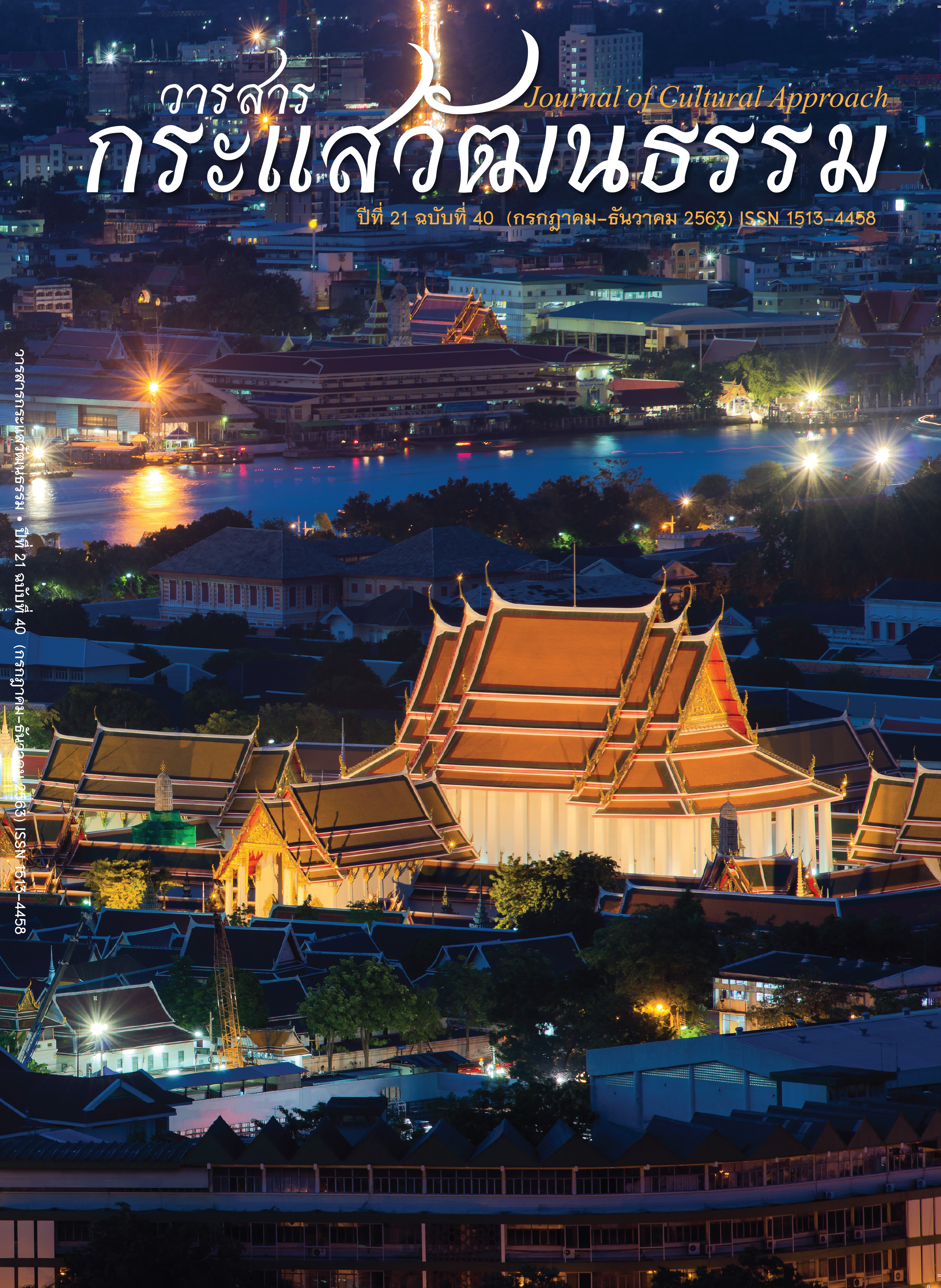แนวทางการพัฒนาสู่การเป็นพื้นที่ท่องเที่ยวเชิงประวัติศาสตร์ของอำเภอพนัสนิคม จังหวัดชลบุรี
Main Article Content
บทคัดย่อ
บทความชิ้นนี้มีวัตถุประสงค์เพื่อนำเสนอให้เห็นถึงศักยภาพของอำเภอพนัสนิคม จังหวัดชลบุรี ในการที่จะได้รับการพัฒนาขึ้นเป็นพื้นที่ท่องเที่ยวในรูปแบบต่างๆ โดยการลงสำรวจพื้นที่ การเก็บรวบรวมและวิเคราะห์ข้อมูลจากเอกสารและงานวิจัยที่เกี่ยวข้องกับประวัติศาสตร์ อัตลักษณ์และวัฒนธรรมของอำเภอพนัสนิคม ซึ่งผลการศึกษาพบว่า อำเภอพนัสนิคมเป็นพื้นที่ที่มีศักยภาพเหมาะจะพัฒนาขึ้นเป็นแหล่งท่องเที่ยว เนื่องจากประกอบด้วยทรัพยากรท่องเที่ยวสำคัญ กล่าวคือ 1.ทรัพยากรท่องเที่ยวประเภทประวัติศาสตร์ อันได้แก่ โบราณสถานเมืองพระรถ โบราณสถานเนินดินโคกพนมดี โบราณสถานวัดใต้ต้นลาน และโบราณวัตถุที่ถูกขุดพบในพื้นที่อำเภอพนัสนิคม และ 2. ทรัพยากรท่องเที่ยวประเภทศิลปวัฒนธรรม ประเพณีและกิจกรรมอันได้แก่ การผลิตเครื่องจักสาน งานประเพณีบุญกลางบ้าน งานประเพณีไหว้พระจันทร์ การเต้นเอ็งกอ และ 3. ทรัพยากรท่องเที่ยวทางธรรมชาติ อันได้แก่ จุดชมค้างคาวแม่ไก่วัดหลวงพรหมาวาส
นอกจากนี้อำเภอพนัสนิคมยังมีปัจจัยสนับสนุนศักยภาพการท่องเที่ยวที่สำคัญ คือการมีทุนสังคม (Social Capital) ในระดับเข้มแข็ง คือความสมัครสมานสามัคคีของคนในอำเภอพนัสนิคม ที่ร่วมแรงร่วมใจกันจัดงานประเพณีต่างๆ ของท้องถิ่นกันเป็นประจำทุกปี และร่วมกันสืบทอดกิจกรรมการละเล่นพื้นบ้านได้อย่างเหนียวแน่นมาจนถึงปัจจุบัน ด้วยเล็งเห็นความสำคัญในการสืบสานประเพณีเก่าแก่ของท้องถิ่นให้ดำรงอยู่ต่อไปในรุ่นลูกหลาน
Article Details
Proposed Creative Commons Copyright Notices
1. Proposed Policy for Journals That Offer Open Access
Authors who publish with this journal agree to the following terms:
- Authors retain copyright and grant the journal right of first publication with the work simultaneously licensed under a Creative Commons Attribution License that allows others to share the work with an acknowledgement of the work's authorship and initial publication in this journal.
- Authors are able to enter into separate, additional contractual arrangements for the non-exclusive distribution of the journal's published version of the work (e.g., post it to an institutional repository or publish it in a book), with an acknowledgement of its initial publication in this journal.
- Authors are permitted and encouraged to post their work online (e.g., in institutional repositories or on their website) prior to and during the submission process, as it can lead to productive exchanges, as well as earlier and greater citation of published work (See The Effect of Open Access).
Proposed Policy for Journals That Offer Delayed Open Access
Authors who publish with this journal agree to the following terms:
- Authors retain copyright and grant the journal right of first publication, with the work [SPECIFY PERIOD OF TIME] after publication simultaneously licensed under a Creative Commons Attribution License that allows others to share the work with an acknowledgement of the work's authorship and initial publication in this journal.
- Authors are able to enter into separate, additional contractual arrangements for the non-exclusive distribution of the journal's published version of the work (e.g., post it to an institutional repository or publish it in a book), with an acknowledgement of its initial publication in this journal.
- Authors are permitted and encouraged to post their work online (e.g., in institutional repositories or on their website) prior to and during the submission process, as it can lead to productive exchanges, as well as earlier and greater citation of published work (See The Effect of Open Access).
References
Amorn Praphan. (2011). Guidelines for Local Museum Establishment: A Case Study of Naphrathat Sub–district, Panasnikom District, Chonburi Province. Faculty of Political Science and Law, Burapha University.
Anchalee Khongthong. (2010). Model of Professional Development Wicker in Phanatnikom District, Chonburi. Department of Public Administration, College of Local Administration, Khon Kaen University.
Baramee Lerdpaisan. (1999). Livable City Project: Case Study of Phanat Nikom Municipality. Graduate School of Public Administration, Burapha University.
Boonlert Jittangwattana. (2005). Tourism Industry. Bangkok: CP Book Standard.
Kalyanee Boonkird et al. (2006). On the Population Ecology of Lyle’s Flying Fox, Pteropus Lylei, at Wat Pormmawas, Chon Buri Province. Wildlife Yearbook, 7, 147–155.
Kham Bunnag. (1961).Royal Historical Record of King Rama II Volume 2. Bangkok: Printing House of the Teacher’s Council.
Luo, H. & Ma, L. (2004). The Strengthened Concept of Dai People’s Identity in the Tradition Culture Co–existence and Conflict: the Research of Dai Theme Parks. Paper presented at the International Conference on Impact of Globalization, Regionalism and Nationalism on Ethnic Peoples in Southeast Asia. Social Research Institute, Chiang Mai University, on 15–17 November.
Mingsarn Kaosa–ard. (2012). Tourism from Policy to Grassroots. 2nd ed. Bangkok: Public Policy Studies Institute.
Ministry of Culture. (1940). Story of Phanat Nikom. Cremation Books of Thaw Boonchan Thummanon, April 4, 1940, Wat Debsirindrawas Ratchaworawihan. Bangkok.
Patcharin Rujiranukul. (2013). The Inheritance Process and Guidelines to Preserve Local Wisdom: A Case Study of Riddle Game in Phanatnikom, Chonburi. Rambhai Barni Rajabhat University.
Somdul Thamnao & Khongsak Saiaram. (2003). Phra Phanatsabodee at Phanat Nikom. Chonburi.
Somdul Thamnao. (2009). Legend of Phra Rot–Meree at Phanat Nikom. Chonburi: Kamonsilp.
Somdul Thamnao. (2013). Legend of Phra Rot–Meree: Guide Book for Field Visit in Phanat Nikom since Intaphat Nakorn and Phra Rot Ancient City. Chonburi: Kamonsilp.
Sujit Wongthes. (2016). Laotian in Phanat Nikom Help Defeated Chinese Secret Society. Retrieved October 28, 2017, from http://www.matichon.co.th/news/140981
Sujit Wongthes. (2016). Phra Phanatsabodee of Phra Rot Ancient City, Who Has Seen the Real One? Retrieved October 27, 2017, from https://www.matichon.co.th/news/155040
Thailand Tourism Directory. (n.d.). Wat Khok Phanom Di. Retrieved from http://thailandtourismdirectory.go.th/en/info/attraction/compare/itemid/2311

